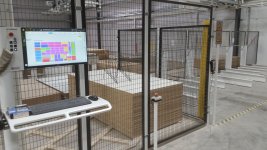Crazyraceguy
Member
- Joined
- Oct 16, 2015
- Messages
- 5,067
I thought I would post a few pics of these because most people have never seen a system like this.
It's a huge upgrade to the way we work. It make sheet goods handling vary easy. A huge overhead gantry/crane moves/stores the material and can deliver it to the beam saw or one of the CNC machines. It keeps inventory under control and takes full sheet handling out of the equation at the same time. It's amazing to watch it work and knowing how many sheets of any given product and where they are is such a time saver.
The first pic shows the computer screen with all of the locations where it can stack and part of the control cage. The second one is the vacuum module of the crane and the last one is the out-feed area of the saw.
We struggled for 10 years in a 20k sq foot building, even doing and addition out back for storage.
This system takes up quite a bit of space, but the speed, accuracy and efficiency are more than worth it. Now that we are in 60k sq feet, things are much more open and movement is easy.
It's a huge upgrade to the way we work. It make sheet goods handling vary easy. A huge overhead gantry/crane moves/stores the material and can deliver it to the beam saw or one of the CNC machines. It keeps inventory under control and takes full sheet handling out of the equation at the same time. It's amazing to watch it work and knowing how many sheets of any given product and where they are is such a time saver.
The first pic shows the computer screen with all of the locations where it can stack and part of the control cage. The second one is the vacuum module of the crane and the last one is the out-feed area of the saw.
We struggled for 10 years in a 20k sq foot building, even doing and addition out back for storage.
This system takes up quite a bit of space, but the speed, accuracy and efficiency are more than worth it. Now that we are in 60k sq feet, things are much more open and movement is easy.




